City in California, United States
| Beverly Hills, California | |
|---|---|
| City | |
 Beverly Hills City Hall Beverly Hills City Hall Rodeo Drive Rodeo Drive Motion Picture Academy Motion Picture Academy Beverly Wilshire Hotel Beverly Wilshire Hotel Beverly Cañon Gardens Beverly Cañon Gardens | |
 Flag Flag Seal Seal Shield Shield | |
| Nicknames: "Garden Spot of the World," "B.H.," "Bev Hills," "90210," | |
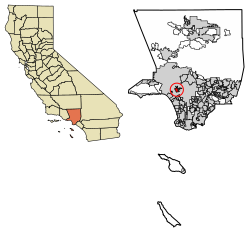 Location within Los Angeles County, California. Location within Los Angeles County, California. | |
   | |
| Coordinates: 34°4′23″N 118°23′58″W / 34.07306°N 118.39944°W / 34.07306; -118.39944 | |
| Country | United States |
| State | California |
| County | Los Angeles |
| Incorporated | January 28, 1914 |
| Named for | Beverly Farms in Beverly, Massachusetts |
| Government | |
| • Type | Council–manager |
| • Mayor | Lester Friedman |
| • Vice mayor | Sharona Nazarian |
| • City council | John Mirisch Craig Corman Mary Wells |
| • City manager | Nancy Hunt-Coffey |
| Area | |
| • Total | 5.71 sq mi (14.79 km) |
| • Land | 5.71 sq mi (14.78 km) |
| • Water | 0.00 sq mi (0.00 km) 0.04% |
| Elevation | 259 ft (79 m) |
| Population | |
| • Total | 32,701 |
| • Density | 5,728.98/sq mi (2,212.00/km) |
| Time zone | UTC−8 (Pacific) |
| • Summer (DST) | UTC−7 (PDT) |
| ZIP codes | 90209–90213 |
| Area codes | 310/424, 323 |
| FIPS code | 06-06308 |
| GNIS feature IDs | 1652672, 2409840 |
| Website | beverlyhills.org |
Beverly Hills is a city located in Los Angeles County, California, United States. A notable and historic suburb of Los Angeles, it is located just southwest of the Hollywood Hills, approximately 12.2 miles (19.6 km) northwest of downtown Los Angeles. Beverly Hills' land area totals 5.71 square miles (14.8 km) and (together with the neighboring smaller city of West Hollywood to the east) is entirely surrounded by the city of Los Angeles. According to the 2020 census, the city has a population of 32,701, marking a decrease of 1,408 from the 2010 census count of 34,109.
In American popular culture, Beverly Hills has been known primarily as an affluent location within Greater Los Angeles, which corresponds to higher property values and taxes in the area. The city is well known for its Rodeo Drive shopping district that includes many designer brands. Throughout its history, the city has been home to many celebrities. It is noted for numerous hotels and resorts, including the Beverly Hilton and the Beverly Hills Hotel. The city has been featured in many movies, television series, music, and media, in the United States and internationally.
After its initial settlement in 1828, Beverly Hills was originally a primarily agricultural community centered around Rancho Rodeo de las Aguas, a Mexican era rancho grant. Beverly Hills was first incorporated as a city in September 1914 by a group of investors who had failed to find oil but found water instead and eventually decided to develop it into a town.
History
Early history
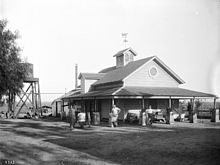
Gaspar de Portolá arrived in the area that would later become Beverly Hills on August 3, 1769, traveling along native trails which followed the present-day route of Wilshire Boulevard. The area was settled by Californio ranchera María Rita Quinteros de Valdez and her husband in 1828. They called their 4,500 acres (18 km) of property the Rancho Rodeo de las Aguas. In 1854, she sold the ranch to Benjamin Davis Wilson (1811–1878) and Henry Hancock (1822–1883). By the 1880s, the ranch had been subdivided into parcels of 75 acres (0.30 km) and was being rapidly bought up by Anglos from Los Angeles and the East coast.
Henry Hammel and Andrew H. Denker acquired most of it and used it for farming lima beans. At this point, the area was known as the Hammel and Denker Ranch. By 1888, they were planning to build a town called Morocco on their holdings.
20th century

In 1900, Burton E. Green, Charles A. Canfield, Max Whittier, Frank H. Buck, Henry E. Huntington, William G. Kerckhoff, William F. Herrin, W.S. Porter, and Frank H. Balch formed the Amalgamated Oil Company, bought the Hammel and Denker ranch, and began looking for oil. They did not find enough to exploit commercially by the standards of the time, though. In 1906, therefore, they reorganized as the Rodeo Land and Water Company, renamed the property "Beverly Hills", subdivided it, and began selling lots. The development was named "Beverly Hills" after Beverly Farms in Beverly, Massachusetts, and because of the hills in the area.
The Los Angeles Times reported on September 2, 1906:
Percy H. Clark Company are managing the development of the foothill portion of the Hammel & Denker ranch for the Rodeo Land and Water Company (the Canfield-Huntington-Kerckhoff syndicate), to be known as Beverly Hills. No expense is being spared to make this a fine suburban district. . . . The property has been laid out on beautiful curved lines.
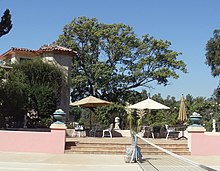
The first house in the subdivision was built in 1907, but sales remained slow.
Restrictive covenants
Beverly Hills was one of many all-white planned communities started in the Los Angeles area around this time. Restrictive covenants prohibited non-whites from owning or renting property, unless they were employed as servants by white residents. It was also forbidden to sell or rent property to Jews in Beverly Hills.
Incorporation
Burton Green began construction on The Beverly Hills Hotel in 1911. The hotel was finished in 1912. The visitors drawn by the hotel were inclined to purchase land in Beverly Hills, and by 1914 the population had grown enough to qualify for incorporation as an independent city. That same year, the Rodeo Land and Water Company decided to separate its water business from its real estate business. The Beverly Hills Utility Commission was split off from the land company and incorporated in September 1914, buying all of the utilities-related assets from the Rodeo Land and Water Company.

In 1919, Douglas Fairbanks and Mary Pickford bought land on Summit Drive and built a mansion, finished in 1921 and nicknamed "Pickfair" by the press. The glamour associated with Fairbanks and Pickford as well as other movie stars who built mansions in the city contributed to its growing appeal.
Water supply
By the early 1920s, the population of Beverly Hills had grown enough to make the water supply a political issue. In 1923, the usual solution, annexation to the city of Los Angeles, was proposed. There was considerable opposition to annexation among such famous residents as Pickford, Fairbanks, Will Rogers and Rudolph Valentino. The Beverly Hills Utility Commission, opposed to annexation as well, managed to force the city into a special election and the plan was defeated 337 to 507.

In 1928, the Beverly Wilshire Apartment Hotel (now the Beverly Wilshire Hotel) opened on Wilshire Boulevard between El Camino and Rodeo drives, part of the old Beverly Hills Speedway. That same year, oilman Edward L. Doheny finished construction of Greystone Mansion, a 55-room mansion meant as a wedding present for his son Edward L. Doheny Jr. The house is now owned by the city of Beverly Hills and is a designated historical landmark.
In the early 1930s, Santa Monica Park was renamed Beverly Gardens and was extended to span the entire two-mile (3-kilometer) length of Santa Monica Boulevard through the city. The Electric Fountain marks the corner of Santa Monica Blvd. and Wilshire Blvd. with a small sculpture at the top of a Tongva kneeling in prayer. In April 1931, the new Italian Renaissance-style Beverly Hills City Hall was opened.
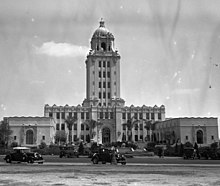
1948: restrictive covenants found unenforceable
In the early 1940s, black actors and businessmen had begun to move into Beverly Hills, despite the covenants allowing only whites to live in the city. A neighborhood improvement association attempted to enforce the covenants in court. The defendants included prominent artists Hattie McDaniel, Louise Beavers, and Ethel Waters. Among the white residents supporting the lawsuit against blacks was Harold Lloyd, the silent film star. The NAACP participated in the defense, which was successful. In his decision, federal judge Thurmond Clarke said that it was time that "members of the Negro race are accorded, without reservations or evasions, the full rights guaranteed to them under the 14th amendment." The United States Supreme Court declared restrictive covenants unenforceable in 1948 in Shelley v. Kraemer. A group of Jewish residents of Beverly Hills filed an amicus brief in this case.
In 1956, Paul Trousdale (1915–1990) purchased the Doheny Ranch and developed it into Trousdale Estates, convincing the city of Beverly Hills to annex it. The neighborhood has been home to Elvis Presley, Frank Sinatra, Dean Martin, Tony Curtis, Ray Charles, and President Richard Nixon, as well as, in later years, Jennifer Aniston, David Spade, Vera Wang and John Rich.
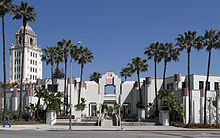
Following the 1979 Islamic Revolution in Iran, many Persian Jews settled in Beverly Hills.
In the late 1990s, the Los Angeles County Metropolitan Transportation Authority (LACMTA) proposed to build an extension of the Metro D Line along Wilshire Boulevard and into Downtown Beverly Hills, but the city opposed it. The D Line Extension will ultimately be completed by 2027 and will include a station at Wilshire Boulevard and Rodeo Drive.
21st century
In 2001, LACMTA proposed a bus rapid transit route down Santa Monica Boulevard, but this was opposed by the city and never built. This stretch of road is served by less efficient Metro Rapid buses using pre-existing roadways. By 2010, traffic in Beverly Hills and surrounding areas had deteriorated enough that the city's habitual opposition had largely turned to support for subways within the city limits. As part of the D Line Extension project, the D Line of the Los Angeles Metro Rail was intended in 2013 to be extended through Beverly Hills, adding two underground stations at Wilshire/La Cienega and Wilshire/Rodeo by the 2020s.
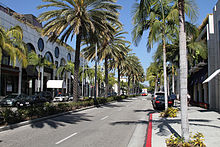
The city of Beverly Hills widely opposed Proposition 8, the 2008 ballot measure which repealed legal recognition of same-sex marriages. The proposition narrowly passed statewide, but in Beverly Hills, only 34% voted in favor, and 66% voted against it.
In the midst of the 2015 drought, Beverly Hills was found to be one of the largest water consumers in California. As a result, it was asked by the state to reduce consumption by 36%, prompting many residents to replace their lawns with native plants. Meanwhile, the city government replaced the grass in front of the City Hall with Mexican sage.
In September 2015, the City of Beverly Hills signed an agreement with Israel to work together on water use as well as "cybersecurity, public health, emergency services, disaster preparedness, public safety, counterterrorism and art and culture".
In July 2016, the City of Beverly Hills received the Livability Award from the United States Conference of Mayors for its Ambassador Program, which takes care of the city's homeless population.
The Beverly Hills Community Dog Park was dedicated on September 6, 2016.
Geography

Beverly Hills and the neighboring city of West Hollywood are together entirely surrounded by the city of Los Angeles. Beverly Hills is bordered on the northwest by the Los Angeles neighborhood of Bel-Air and the Santa Monica Mountains, on the east by West Hollywood, the Carthay neighborhood of Los Angeles, and the Fairfax District of Los Angeles, and on the south by the Beverlywood neighborhood of Los Angeles. The area's "Platinum Triangle" is formed by the city of Beverly Hills and the Los Angeles neighborhoods of Bel Air and Holmby Hills.
The ZIP codes for Beverly Hills are 90209 (P.O. boxes only), 90210, 90211, 90212, and 90213 (P.O. boxes only).
Areas
The Flats
Most residents live in the "flats" of Beverly Hills, which is a relatively flat area that slopes away from the hills, and includes all of Beverly Hills south of Sunset Boulevard and north of Santa Monica Boulevard. This area includes Wallis Annenberg Center for the Performing Arts.
Trousdale Estates
Trousdale Estates is a 410-acre neighborhood of large, luxurious homes in Beverly Hills. It was primarily developed in the 1950s and early 1960s by Paul Trousdale, who petitioned the city to incorporate the land into Beverly Hills soon after purchasing it from the Doheny family. Greystone Mansion, which is listed on the National Register of Historic Places, is in Trousdale Estates. The average sale price of homes in Trousdale is over $10 million.
Downtown Beverly Hills
In a triangle surrounded by Santa Monica Boulevard, Wilshire Boulevard and Crescent Drive is Downtown Beverly Hills, also known as the Golden Triangle, a retail and dining hub attracting locals, and in some sections attracting visitors from across the region and around the world.
- Linden, Roxbury, Bedford and Camden drives, short streets catering to residents' needs, lined with medical offices, bank branches, delicatessens, etc.
- Rodeo Drive, known for high-end boutiques.
- Beverly Drive, lined with upscale chain retailers commonly found in malls. Some restaurants line Beverly Drive as well.
- Cañon and Crescent drives, attracting local and regional shoppers and diners to restaurants such as Spago as well as local favorites, particularly along Cañon.
- Wilshire Boulevard is home to the two department stores remaining in the city: Saks Fifth Avenue, and Neiman Marcus.
South Beverly Drive, i.e. south of Wilshire Boulevard, is another dining and shopping hub.
Houses south of Wilshire Boulevard have more urban square and rectangular lots, in general smaller than those to the north. There are also more apartment buildings south of Wilshire Boulevard than anywhere else in Beverly Hills.
West Gateway
The city’s West Gateway on Wilshire Blvd. borders the Los Angeles Country Club. The gateway features a hospitality complex consisting of The Beverly Hilton, Waldorf Astoria Beverly Hills, and the currently under-construction One Beverly Hills. This development will include the tallest tower in Beverly Hills. Across from this complex is one of the city’s elementary schools, El Rodeo.
South East
The South East is anchored by La Cienega Park, a large park that includes city tennis court complex, baseball field, and soccer fields. The region includes the historic Saban Theater as well as the “Restaurant Row” corridor of La Cienega, including Lawry's, Stinking Rose, and Matsuhisa. It also includes a corridor of medical buildings and office tower, including the Flynt Building, the 99 La Cienega Medical building, and the 240 Medical building. South East Beverly Hills is the site of one of the two Metro D Line stations in the city, the Wilshire/La Cienega station, expected to open in 2025. The area is just south of the Beverly Center and Cedars-Sinai.
Beverly Hills adjacent

Beverly Hills Post Office (BHPO) is the name given to a section directly north of the Beverly Hills city limits that lies within the 90210 ZIP code, assigned to the Beverly Hills Post Office, but is part of the City of Los Angeles.
Along with the Los Angeles communities of Bel-Air and Brentwood, Beverly Hills is one of the "Three Bs", a wealthy area in the Los Angeles Westside.
Climate
Beverly Hills has a warm Mediterranean climate and receives an average 15 inches (380 mm) of rain per year. Summers are marked by warm to hot temperatures with very little wind, while winters are mild to moderate, with occasional rain alternating with periods of Santa Ana winds. Measurable snowfall has been recorded only in 1882, 1922, 1932, 1949 and 1958.
Demographics
| Census | Pop. | Note | %± |
|---|---|---|---|
| 1920 | 674 | — | |
| 1930 | 17,429 | 2,485.9% | |
| 1940 | 26,823 | 53.9% | |
| 1950 | 29,032 | 8.2% | |
| 1960 | 30,817 | 6.1% | |
| 1970 | 33,416 | 8.4% | |
| 1980 | 32,646 | −2.3% | |
| 1990 | 31,971 | −2.1% | |
| 2000 | 33,784 | 5.7% | |
| 2010 | 34,109 | 1.0% | |
| 2020 | 32,701 | −4.1% | |
| U.S. Decennial Census | |||
2010

The 2010 United States Census reported that Beverly Hills had a population of 34,109. The population density was 5,973.1 inhabitants per square mile (2,306.2/km). The racial makeup of Beverly Hills was 28,112 (82.4%) White (78.6% Non-Hispanic White), 746 (2.2%) African American, 48 (0.1%) Native American, 3,032 (8.9%) Asian, 12 (0.0%) Pacific Islander, 485 (1.4%) from other races, and 1,674 (4.9%) from two or more races. Hispanic or Latino of any race were 1,941 persons (5.7%).
The Census reported that 33,988 people (99.6% of the population) lived in households, 121 (0.4%) lived in non-institutionalized group quarters, and 0 (0%) were institutionalized.
There were 14,869 households, out of which 3,759 (25.3%) had children under the age of 18 living in them, 6,613 (44.5%) were opposite-sex married couples living together, 1,354 (9.1%) had a female householder with no husband present, 494 (3.3%) had a male householder with no wife present. There were 460 (3.1%) unmarried opposite-sex partnerships, and 131 (0.9%) same-sex married couples or partnerships. 5,400 households (36.3%) were made up of individuals, and 1,834 (12.3%) had someone living alone who was 65 years of age or older. The average household size was 2.29. There were 8,461 families (56.9% of all households); the average family size was 3.05.
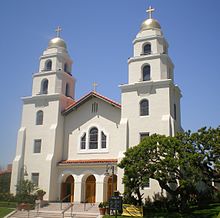
The population was spread out, with 6,623 people (19.4%) under the age of 18, 2,526 people (7.4%) aged 18 to 24, 8,540 people (25.0%) aged 25 to 44, 9,904 people (29.0%) aged 45 to 64, and 6,516 people (19.1%) who were 65 years of age or older. The median age was 43.6 years. For every 100 females, there were 84.3 males. For every 100 females age 18 and over, there were 80.3 males.
There were 16,394 housing units at an average density of 2,870.9 units per square mile (1,108.5 units/km), of which 6,561 (44.1%) were owner-occupied, and 8,308 (55.9%) were occupied by renters. The homeowner vacancy rate was 2.2%; the rental vacancy rate was 8.0%. 17,740 people (52.0% of the population) lived in owner-occupied housing units and 16,248 people (47.6%) lived in rental housing units.
During 2009–2013, Beverly Hills had a median household income of $86,141, with 8.8% of the population living below the federal poverty line.
2000

As of the census of 2000, there were 33,784 people, 15,035 households, and 8,269 families residing in the city. The population density was 5,954.0 inhabitants per square mile (2,298.9/km). There were 15,856 housing units at an average density of 2,794.4/mi (1,079.7/km). The racial makeup of the city was 85.06% White, 1.77% African American, 0.13% Native American, 7.05% Asian, 0.03% Pacific Islander, 1.50% from other races, and 4.46% from two or more races. Hispanic or Latino of any race were 4.63% of the population.
There were 15,035 households, out of which 24.4% had children under the age of 18 living with them, 43.8% were married couples living together, 8.1% had a female householder with no husband present, and 45.0% were non-families. 38.2% of all households were made up of individuals, and 11.3% had someone living alone who was 65 years of age or older. The average household size was 2.24 and the average family size was 3.02.
In the city, the population was spread out, with 20.0% under the age of 18, 6.3% from 18 to 24, 29.3% from 25 to 44, 26.8% from 45 to 64, and 17.6% who were 65 years of age or older. The median age was 41 years. For every 100 females, there were 83.5 males. For every 100 females age 18 and over, there were 79.4 males.
The median income for a household in the city was $70,945, and the median income for a family was $102,611. Males had a median income of $72,004 versus $46,217 for females. The per capita income for the city was $65,507. About 7.9% of families and 9.1% of the population were below the poverty line, including 9.5% of those under the age of 18 and 7.9% ages 65 or older.
Economy

Beverly Hills is home to one Fortune 500 company, Live Nation Entertainment. Since August 22, 2011, the headquarters of Metro-Goldwyn-Mayer have been located in Beverly Hills after a significant film history established close by on the main original studio lots in Culver City. The talent agencies William Morris Endeavor, Paradigm Talent Agency, The Gersh Agency, United Talent Agency, and Agency for the Performing Arts are based in Beverly Hills.
Hilton Hotels Corporation formerly had its corporate headquarters in Beverly Hills. The original headquarters of GeoCities (at first Beverly Hills Internet) was at 9401 Wilshire Boulevard in Beverly Hills.
The large Beverly Hills Oil Field has four urban drilling islands, which drill diagonally into the earth underneath the city. One drilling island occasioned a 2003 lawsuit representing former attendees of Beverly Hills High School, approximately 280 of which having suffered from cancers allegedly tied to the drilling operations. The oil site on the high school grounds is in the process of being shut down.
Top employers in 2015

According to the city's 2015 Comprehensive Annual Financial Report, the top employers in the city were:
| # | Employer | # of Employees |
|---|---|---|
| 1 | City of Beverly Hills | 1,042 |
| 2 | Beverly Hills Unified School District | 642 |
| 3 | Beverly Wilshire Hotel | 620 |
| 4 | The Beverly Hilton | 599 |
| 5 | The Beverly Hills Hotel | 500 |
| 6 | William Morris Agency | 500 |
| 7 | Saks Fifth Avenue | 460 |
| 8 | Neiman Marcus Group | 430 |
| 9 | Creative Artists Agency | 425 |
| 10 | The Peninsula Beverly Hills | 400 |
Government
Municipal government
See also: List of Mayors of Beverly Hills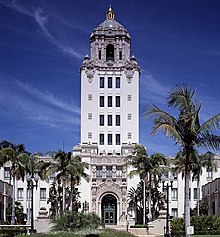
Beverly Hills is a general law city governed by a five-member city council, including the mayor and vice mayor. The city council hires a city manager to carry out policies and serve as executive officer. Until 2017, every odd-numbered year, either two or three members were elected for four-year terms. However, in 2017, the council changed its cycle to conform with statewide elections; the first such election was held in March 2020. Each April, the city council meets and chooses one of its members as mayor and one as vice-mayor. As of April 2024, Lester Friedman is mayor, Sharona Nazarian is vice mayor, and John Mirisch, Craig Corman, and Mary Wells are councilmembers. Nancy Hunt-Coffey serves as city manager.
County, state and federal representation

On the Los Angeles County Board of Supervisors, Beverly Hills is in the Third District, represented by Lindsey Horvath.
In the upper house of the California State Legislature, Beverly Hills is in the 24th Senate District, represented by Democrat Ben Allen. In the lower house, it is in the 51st Assembly District, represented by Democrat Rick Zbur.
In the United States House of Representatives, Beverly Hills is in California's 36th congressional district, represented by Democrat Ted Lieu.
New and existing laws
On January 1, 2022, Beverly Hills became the first city in America to ban the sale of all tobacco products. Smoking lounges and hotels are exempt from the new law. The city council passed the law in June 2021. Flavored tobacco was already banned.
Politics
| Year | Democratic | Republican | Third Parties | |
|---|---|---|---|---|
|
45.43% 8,123 |
50.06% 8,968 |
1.9% 342 | ||
|
55.07% 10,453 |
43.85% 8,325 |
1.06% 203 | ||
|
63.81% 9,743 |
32.63% 4,982 |
3.55% 543 | ||
|
54.27% 8,263 |
43.85% 6,676 |
1.86% 284 | ||
|
59.54% 10,331 |
39.2% 6,801 |
1.25% 217 | ||
|
62% 13,691 |
37.04% 8,168 |
0.86% 190 | ||
|
76.51% 8,399 |
20.47% 2,247 |
3% 331 | ||
|
68.33% 7,188 |
24.69% 2,598 |
6.96% 733 | ||
|
65.69% 8,810 |
20.8% 2,790 |
13.5% 1,811 | ||
|
60.1% 9,702 |
39.3% 6,345 |
0.5% 95 | ||
|
52.71% 7,343 |
46.48% 6,475 |
0.7% 111 | ||
|
39.65% 6,111 |
47.65% 7,344 |
12.69% 1,957 | ||
|
52.05% 8,974 |
46.95% 8,094 |
0.9% 171 | ||
|
49.40% 9,199 |
49.07% 9,135 |
1.5% 282 | ||
|
61.5% 11,138 |
36.9% 6,693 |
1.4% 267 | ||
|
64.9% 11,832 |
35% 6,399 |
In the 2024 Los Angeles County District Attorney election, a significant majority of Beverly Hills voters, 73.51% (13,126 votes), voted for Nathan Hochman, whereas only 17.17% (3,077 votes) backed George Gascón.
In the 2024 Election for California's 36th congressional district, 44.67% (7,978 voters) of Beverly Hills backed Melissa Toomim, whereas 43.71% (7,806 voters) of the city voted for the incumbent, Ted Lieu.
Education

Beverly Hills is served by Beverly Hills Unified School District, which includes two kindergarten-through-fifth-grade schools (Hawthorne and Horace Mann), one middle school (Beverly Vista) and Beverly Hills High School. One alternative school, Moreno High School, shares its campus with the aforementioned Beverly Hills High School.
Beverly Hills also has several private schools. Good Shepherd School, a PreK-8 school, is a part of the Roman Catholic Archdiocese of Los Angeles. Other private schools include Harkham Hillel Hebrew Academy.
Infrastructure

The Beverly Hills Police Department and the Beverly Hills Fire Department serve as emergency response agencies for the city.
The Los Angeles County Department of Health Services SPA 5 West Area Health Office serves Beverly Hills. The department operates the Simms/Mann Health and Wellness Center in Santa Monica, serving Beverly Hills.
The United States Postal Service operates the Beverly Hills Post Office at 325 North Maple Drive, the Crescent Post Office at 323 North Crescent Drive, the Beverly Post Office at 312 South Beverly Drive, and the Eastgate Post Office at 8383 Wilshire Boulevard. The former Beverly Hills Post Office was listed on the National Register of Historic Places on January 11, 1985.
Autonomous vehicles
In April 2016, the Beverly Hills City Council passed a resolution to create autonomous vehicles for public transportation within the next decade. Mayor John Mirisch said this was one of his top priorities during his tenure as mayor. "This is a game-changer for Beverly Hills and, we hope, for the region," said Mirisch in the press release. "Beverly Hills is the perfect community to take the lead to make this technology a reality. It is now both feasible and safe for autonomous cars to be on the road."
Media

Beverly Hills is served by free weekly newspapers The Beverly Hills Courier and Beverly Hills Weekly.
The BHUSD has a public-access television station called KBEV, which is run by the students of Beverly Hills High School.
Landmarks
- Beverly Gardens Park
- Beverly Hills 9/11 Memorial Garden
- Beverly Hills City Hall
- Beverly Hills High School
- Beverly Hills Hotel
- Beverly Hills Police Department
- Beverly Hills Public Library
- Beverly Hills Women's Club
- Beverly Wilshire Hotel
- Electric Fountain
- Greystone Mansion
- Greenacres
- La Cienega Park
- Misty Mountain
- Pickfair
- Rodeo Drive
- Roxbury Memorial Park
- Virginia Robinson Gardens
- Will Rogers Memorial Park
Notable people
Main category: People from Beverly Hills, CaliforniaIn popular culture

Beverly Hills frequently appears in popular culture as a place of conspicuous wealth or luxury, although the actual demographics of the city are more complex. In some films, such as 1990's Pretty Woman, substantial filming took place in the city; in many others, however, such as Beverly Hills Cop (1984), little is shown besides establishing shots of landmarks such as the Beverly Hills Hotel and Rodeo Drive.
Beverly Hills is also featured in the song "Beverly Hills" by the rock band Weezer.
In television, the scene in the opening credits of The Andy Griffith Show (1960–1968), in which Sheriff Taylor and Opie carry fishing poles past a pond, was shot at the Franklin Canyon Reservoir north of the city, just west of Coldwater Canyon. The CBS sitcom The Beverly Hillbillies (1962–71) followed a hillbilly family who relocate to Beverly Hills from the Ozarks. The city also features in the name of the 1990s soap opera Beverly Hills, 90210, revolving around the lives of teenagers attending the fictional West Beverly Hills High School.
The Real Housewives of Beverly Hills is a reality television franchise.
Sister cities
See also
References
- "California Cities by Incorporation Date". California Association of Local Agency Formation Commissions. Archived from the original (Word) on November 3, 2014. Retrieved August 25, 2014.
- ^ "The City of Beverly Hills Mayor and Council Members". Beverlyhills.org. Retrieved March 31, 2017.
- ^ "Biography of Interim City Manager Mahdi Aluzri". City of Beverly Hills. Retrieved February 2, 2015.
- "2020 U.S. Gazetteer Files". United States Census Bureau. Retrieved October 30, 2021.
- "Beverly Hills". Geographic Names Information System. United States Geological Survey, United States Department of the Interior. Retrieved October 20, 2014.
- ^ "USPS – ZIP Code Lookup – Search By City". United States Postal Service. Archived from the original on September 3, 2007. Retrieved June 18, 2010.
- "Downtown Los Angeles to Beverly Hills". Downtown Los Angeles to Beverly Hills. Retrieved December 8, 2022.
- "QuickFacts: Beverly Hills city, California". US Census. U.S. Census Bureau. Retrieved May 15, 2022.
- ^ "History of Beverly Hills". City of Beverly Hills. Retrieved April 25, 2012.
- ^ Marc Wanamaker (November 16, 2005). Early Beverly Hills. Arcadia Publishing. ISBN 978-0-7385-3068-0. Retrieved August 17, 2012.
- Joy Horowitz (July 19, 2007). Parts Per Million: The Poisoning of Beverly Hills High School. Penguin. p. 42. ISBN 978-0-670-03798-8. Retrieved August 17, 2012.
- ^ Michael Gross (November 1, 2011). Unreal Estate: Money, Ambition, and the Lust for Land in Los Angeles. Random House Digital, Inc. ISBN 978-0-7679-3265-3. Retrieved August 17, 2012.
- ^ Alexander Garvin (June 19, 2002). The American City. McGraw-Hill Professional. p. 383. ISBN 978-0-07-137367-8. Retrieved August 18, 2012.
- ^ Marc Wanamaker, Early Beverly Hills, Mount Pleasant, South Carolina: Arcadia Publishing, 2005, pp. 17–18
- Robert M. Fogelson (September 28, 2007). Bourgeois Nightmares: Suburbia, 1870–1930. Yale University Press. p. 186. ISBN 978-0-300-12417-0. Retrieved August 18, 2012.
- "(Source requires subscription)". Los Angeles Times. September 2, 1906. p. 74 – via Newspapers.com.
- ^ Marc Wanamaker (October 18, 2006). Beverly Hills: 1930–2005. Arcadia Publishing. p. 69. ISBN 978-0-7385-4659-9. Retrieved August 18, 2012.
- James W. Loewen (September 29, 2005). Sundown Towns: A Hidden Dimension Of American Racism. The New Press. p. 112. ISBN 978-1-59558-674-2. Retrieved August 19, 2012.
- Andrew Wiese (December 15, 2005). Places of Their Own: African American Suburbanization in the Twentieth Century. University of Chicago Press. p. 42. ISBN 978-0-226-89625-0. Retrieved August 19, 2012.
- Railroad Commission of the State of California (1919). Decisions of the Railroad Commission of the State of California. Superintendent of State Printing. p. 897. Retrieved August 18, 2012.
- ^ Robert Fishman (March 31, 1989). Bourgeois Utopias: The Rise And Fall Of Suburbia. Basic Books. p. 168. ISBN 978-0-465-00747-9. Retrieved August 18, 2012.
- Karie Bible; Marc Wanamaker; Harry Medved (November 29, 2010). Location Filming in Los Angeles. Arcadia Publishing. p. 93. ISBN 978-0-7385-8132-3. Retrieved August 18, 2012.
- Debra Ann Pawlak (January 10, 2012). Bringing Up Oscar: The Story of the Men and Women Who Founded the Academy. Open Road Media. p. 135. ISBN 978-1-4532-2618-6. Retrieved August 18, 2012.
- Norma Zager (October 1, 2010). Erin Brockovich and the Beverly Hills Greenscam. Pelican Publishing. p. 141. ISBN 978-1-58980-810-2. Retrieved August 18, 2012.
- Clarence Y. H. Lo (January 23, 1990). Small Property versus Big Government: Social Origins of the Property Tax Revolt, Expanded and Updated edition. University of California Press. p. 164. ISBN 978-0-520-05971-9. Retrieved August 18, 2012.
- Linda Bauer; Steve Bauer (November 1, 2008). Recipes from Historic California: A Restaurant Guide and Cookbook. Taylor Trade Publications. p. 199. ISBN 978-1-58979-348-4. Retrieved August 18, 2012.
- Scott B. MacDonald; Jane Elizabeth Hughes (February 28, 2009). Separating Fools from Their Money: A History of American Financial Scandals. Transaction Publishers. p. 100n. ISBN 978-1-4128-1054-8. Retrieved August 18, 2012.
- Stephen Grant Meyer (October 1, 2001). As Long As They Don't Move Next Door: Segregation and Racial Conflict in American Neighborhoods. Rowman & Littlefield. p. 76. ISBN 978-0-8476-9701-4. Retrieved August 19, 2012.
- Steve Sheppard (April 1, 2007). The History of Legal Education in the United States: Commentaries And Primary Sources. The Lawbook Exchange, Ltd. p. 948n. ISBN 978-1-58477-690-1. Retrieved August 19, 2012.
- Myrna Oliver, Lucy Doheny Battson, 100; Family Made Fortune in Oil, The Los Angeles Times, June 22, 1993
- Bonino, Mary Ann (October 4, 2018). The Doheny Mansion: A Biography of a Home. MaryAnn Bonino. ISBN 9780981642208. Retrieved October 4, 2018 – via Google Books.
- Sloper, Don (October 4, 2018). Los Angeles's Chester Place. Arcadia Publishing. ISBN 9780738546872. Retrieved October 4, 2018 – via Google Books.
- ^ Erika Riggs, Elvis' Beverly Hills home goes on the market, NBC
- Wanamaker, Marc (October 4, 2018). Early Beverly Hills. Arcadia Publishing. ISBN 9780738530680. Retrieved October 4, 2018 – via Google Books.
- Ann Herold, Trousdale Estates Archived May 14, 2013, at the Wayback Machine, Los Angeles, January 9, 2012
- "History and Other Facts". Trousdale Estates Homeowners Association. Retrieved August 24, 2014.
- Max Feeney, Nixon at the Movies: A Book about Belief, Chicago, Illinois: University of Chicago Press, 2012, p. 38
- Lauren Beale, Hot Property: TV and film director John Rich lists Trousdale Estates home at $11.9 million, Los Angeles Times, June 6, 2011
- Iranian Jews Find a Beverly Hills Refuge : Immigrants: Khomeini’s revolution drove 40,000 of them into exile. At least 30,000 may live in or near the city that symbolizes wealth.
- A look inside the elite Iranian Jewish community of Beverly Hills.
- A New Persian Empire : Immigrants: Thousands of Jewish Iranians settled in the Beverly Hills area during the revolution. Unlike other waves of immigrants, this was one of the richest. Although many have found success, they have had to adjust to life in the U.S.
- ^ Schwieterman, Joseph P. (2004). When the Railroad Leaves Town: American Communities in the Age of Rail Line Abandonment, Western United States. Kirksville, Missouri: Truman State University Press. p. 32. ISBN 978-1-931112-13-0. OL 8801889M.
- Austin Troy (January 10, 2012). The Very Hungry City: Urban Energy Efficiency and the Economic Fate of Cities. Yale University Press. p. 201. ISBN 978-0-300-16231-8. Retrieved August 18, 2012.
- L.A. Metro. "Summer 2013 – General Fact Sheet – Purple Line Extension" (PDF). Retrieved July 25, 2013.
- Welsh, Ben. "Gay marriage ban: How cities in Los Angeles County voted". Los Angeles Times. Archived from the original on April 5, 2013.
- Carlton, Jim (May 5, 2015). "Nowhere Is Safe From California Drought—Not Even Beverly Hills". The Wall Street Journal. Retrieved January 8, 2017.
- Torok, Ryan (September 8, 2015). "L.A. County, Beverly Hills discuss their own water deals with Israel". The Jewish Journal of Greater Los Angeles. Retrieved August 17, 2016.
- Talbot, Victoria (July 1, 2016). "Beverly Hills Receives Livability Award From USCM for Second Time" (PDF). The Beverly Hills Courier. Vol. L1, no. 27. p. 17. Archived from the original (PDF) on July 12, 2017. Retrieved July 1, 2016.
- Talbot, Victoria (September 6, 2016). "Beverly Hills Community Dog Park Opens Today". The Beverly Hills Courier. Archived from the original on September 24, 2016. Retrieved August 22, 2016.
- "Dog Park: Events- Grand Opening Ceremony". City of Beverly Hills. Archived from the original on September 9, 2016. Retrieved September 6, 2016.
- Google map
- Price, Steven M. (January 17, 2017). Trousdale Estates: Midcentury to Modern in Beverly Hills. Dunning, Brad; Schmidt, Stephen. New York, NY: Regan Arts. ISBN 9781941393376. OCLC 961859428.
- "History of Greystone". beverlyhills.org. Retrieved September 5, 2019.
- "Trousdale Estates, Los Angeles Housing Market: House Prices & Trends". Redfin. Retrieved September 3, 2019.
- ^ "Restaurants in Beverly Hills".
- "The Best Dining, Shopping, & Things To Do on South Beverly Drive", Beverly Hills Conference & Visitors Bureau
- "Home - Los Angeles Country Club". www.thelacc.org. Retrieved December 30, 2024.
- Sharp, Steven (February 12, 2024). "Construction begins for skyline-altering One Beverly Hills development | Urbanize LA". la.urbanize.city. Retrieved December 30, 2024.
- X; Instagram; Email; Facebook (February 8, 2024). "Work begins on transformative condo and hotel development in Beverly Hills". Los Angeles Times. Retrieved December 30, 2024.
{{cite web}}:|last2=has generic name (help) - "El Rodeo Elementary School". er.bhusd.org. December 30, 2024. Retrieved December 30, 2024.
- Coleman, Laura (September 13, 2019). "City Makes Moves to Enliven Southeast Part of Beverly Hills". Beverly Hills Courier. Retrieved December 30, 2024.
- , Mindgruve, Inc. . "Restaurant Row on La Cienega Boulevard". lovebeverlyhills.com. Archived from the original on September 10, 2024. Retrieved December 30, 2024.
{{cite web}}: CS1 maint: multiple names: authors list (link) - Baum, Merle Ginsberg & Gary (April 18, 2014). "Why Larry Flynt's Name Was Replaced on Hustler's Headquarters". The Hollywood Reporter. Retrieved December 30, 2024.
- "FAQs • When will the Wilshire/La Cienega Station open for su". beverlyhills.org. Retrieved December 30, 2024.
- Bozorgmehr, Mehdi, Claudia Der-Martirosian, and Georges Sabagh. "Middle Easterners: A New Kind of Immigrant" (Chapter 12). In: Waldinger, Roger and Mehdi Bozorgmehr (editors). Ethnic Los Angeles. Russell Sage Foundation, December 5, 1996. Start page 345. ISBN 1610445473, ISBN 9781610445474. Cited: p. 347. "in Beverly Hills, Bel Air, and Brentwood, known in local parlance as "the three Bs.""
- Melton, Mary. "The Stars of Star Maps." Los Angeles Times. August 25, 1996. "Each map tends to cover the "three Bs": Brentwood, Bel-Air and Beverly Hills. A few toss in a Malibu sidebar."
- Myers, David W. "A Sad Westside Story : Home Prices Have Declined as Much as 50% Since the 1980s." Los Angeles Times. May 28, 1993. Retrieved on July 4, 2014. "But, as Meyer's case suggests, nowhere have those losses been as dramatic as the high-priced area on the Westside known as the "three Bs"--Brentwood, Bel-Air and Beverly Hills."
- "Census of Population and Housing". Census.gov. Retrieved June 4, 2015.
- "2010 Census Interactive Population Search: CA – Beverly Hills city". U.S. Census Bureau. Archived from the original on July 15, 2014. Retrieved July 12, 2014.
- ^ "Beverly Hills (city) QuickFacts". United States Census Bureau. Archived from the original on August 19, 2012. Retrieved February 9, 2015.
- "U.S. Census website". United States Census Bureau. Retrieved January 31, 2008.
- CBS - Beverly Hills Streets Named 2nd And 3rd Most Expensive In America
- Beverly Hills Internet, Builder of Web Communities, Changes Name to GeoCities; Monthly Page. Archived December 11, 2008, at the Wayback Machine Business Wire. Thursday December 14, 1995. Retrieved April 29, 2010.
- Horowitz, Joy. Parts per million: the poisoning of Beverly Hills High School. p. 8. Viking, 2007. ISBN 0-670-03798-2.
- "BHHS Oil Well". KBEV – Beverly Hills. Archived from the original on September 5, 2019. Retrieved September 5, 2019.
- "Beverly Hills City Council changing election cycles". Park Labrea News/ Beverly Press. October 5, 2017.
- "Mayor and Councilmembers". www.beverlyhills.org.
- "The 3rd District". Archived from the original on May 31, 2022. Retrieved January 16, 2022.
- "Statewide Database". UC Regents. Archived from the original on February 1, 2015. Retrieved November 23, 2014.
- "Beverly Hills, Calif.'s Tobacco Sales Ban Now in Effect, Cigar Lounges Remain Exempt". January 2021.
- Wolcott, Holly. "Statement of Votes Cast by District" (PDF). Retrieved November 5, 2024.
- Padilla, Alex (November 3, 2020). "Supplement to Statement of Vote" (PDF).
{{cite web}}: CS1 maint: url-status (link) - Padilla, Alex (November 8, 2016). "Supplement to Statement of Vote" (PDF).
{{cite web}}: CS1 maint: url-status (link) - Bowen, Debra (November 6, 2012). "Supplement to Statement of Vote" (PDF).
{{cite web}}: CS1 maint: url-status (link) - Bowen, Debra (November 4, 2008). "Supplement to the Statement of Vote" (PDF).
{{cite web}}: CS1 maint: url-status (link) - Shelley, Kevin (November 2, 2004). "Supplement to the Statement of Vote" (PDF).
{{cite web}}: CS1 maint: url-status (link) - Jones, Bill (November 7, 2000). "Supplement to the Statement of vote" (PDF).
- California. Secretary of State (1968). Statement of vote. San Francisco Public Library. Sacramento, Calif. : The Secretary.
- California. Secretary of State (1968). Statement of vote. San Francisco Public Library. Sacramento, Calif. : The Secretary.
- California. Secretary of State (1968). Statement of vote. San Francisco Public Library. Sacramento, Calif. : The Secretary.
- California. Secretary of State (1968). Statement of vote. San Francisco Public Library. Sacramento, Calif. : The Secretary.
- California. Secretary of State (1968). Statement of vote. San Francisco Public Library. Sacramento, Calif. : The Secretary.
- California. Secretary of State (1968). Statement of vote. San Francisco Public Library. Sacramento, Calif. : The Secretary.
- California. Secretary of State (1968). Statement of vote. San Francisco Public Library. Sacramento, Calif. : The Secretary.
- California. Secretary of State (1962). California statement of vote. San Francisco Public Library. : Secretary of State.
- California. Secretary of State (1962). California statement of vote. San Francisco Public Library. : Secretary of State.
- Wolcott, Holly (November 5, 2024). "Statement of Votes Cast by District" (PDF).
{{cite web}}: CS1 maint: url-status (link) - Wolcott, Holly (November 5, 2024). "Supplement to the statement of vote" (PDF).
- "SPA5 – West Area Health Office." Los Angeles County Department of Health Services. Retrieved April 29, 2010.
- "Simms/Mann Health and Wellness Center." Los Angeles County Department of Health Services. Retrieved April 29, 2010.
- "Post Office Location – BEVERLY HILLS". United States Postal Service. Archived from the original on December 24, 2008. Retrieved April 29, 2010.
- "Post Office Location – CRESCENT". United States Postal Service. Archived from the original on December 24, 2008. Retrieved April 29, 2010.
- "Post Office Location – BEVERLY". United States Postal Service. Archived from the original on December 24, 2008. Retrieved April 29, 2010.
- "Post Office Location – EASTGATE". United States Postal Service. Archived from the original on December 24, 2008. Retrieved April 29, 2010.
- Official Zoning Map (Map). City of Beverly Hills. Retrieved April 29, 2010.
- "National Register Information System". National Register of Historic Places. National Park Service. July 9, 2010.
- "Autonomous Vehicles". Beverlyhills.org. Retrieved April 24, 2016.
- "City Council Passes Resolution Creating Autonomous Vehicle Program : A.V. Summit to Be Held in Beverly Hills This Fall" (PDF). Beverlyhills.org. Retrieved October 4, 2018.
- "Grayson Brulte | Brulte & Company". Brulte & Company. Retrieved April 24, 2016.
- Vincent, James (April 18, 2016). "Beverly Hills wants to upgrade its public transportation with self-driving cars". The Verge. Retrieved April 24, 2016.
- "KBEV Live!". kbev6.com. Archived from the original on February 5, 2012. Retrieved August 19, 2012.
- Ferrell, David (January 28, 1990), "Town That Tells Time on a Rolex : Beverly Hills is a small place really. It's money and glitz that make it different and, for most, irresistible", The Los Angeles Times, retrieved October 15, 2020
- "Take a walk to Andy Griffith's Mayberry in Franklin Canyon". LA Times Blogs. July 7, 2012. Retrieved January 27, 2017.
- Itzkoff, Dave (August 29, 2008). "When Teenage Angst Had Its Own ZIP Code". The New York Times. Retrieved February 15, 2020.
- Herbert, Steven (July 7, 1991). "A Post-Graduate Commentary". Los Angeles Times. Retrieved February 15, 2020.
- "Bravo Adds Fifth Night of Programming, Boosting Original Hours by 20% - Ratings | TVbytheNumbers". Archived from the original on November 4, 2012.
- ^ "Beverly Hills Sister City Relationships Renewed with Focus on Education and Commerce". Sister Cities International. March 7, 2002. Retrieved August 17, 2012.
- ^ "Sister Cities Committee". City of Beverly Hills. July 1, 2019. Retrieved July 1, 2019.
- Edwards, Nick; Hodgkins, Charles; Keeling, Stephen (May 1, 2014). The Rough Guide to California. Rough Guides Limited. ISBN 978-0-241-00764-8.
- Fleming, E. J. (January 1, 2000). Hollywood Death and Scandal Sites: Sixteen Driving Tours with Directions and the Full Story, from Tallulah Bankhead to River Phoenix. McFarland. ISBN 978-0-7864-0160-4.
Bibliography
- Beverly Hills: 1930–2005 By Marc Wanamaker ISBN 9780738546599
- Beverly Hills: An Illustrated History by Genevieve Davis ISBN 978-0-89781-238-2
- Beverly Hills: Inside the Golden Ghetto By Walter Wagner Published 1976
- "History of Beverly Hills." By Pierce E. Benedict. Published 1934.
External links
- Official website

- Beverly Hills City photographs
- Beverly Hills article at Encyclopaedia Britannica
- Beverly Hills profile from the Los Angeles Times
| Places adjacent to Beverly Hills, California | |
|---|---|
| Beverly Hills, California | |
|---|---|
| Education | |
| Primary and secondary schools | |
| Other education | |
| Government | |
| City government | |
| Other | |
| Hotels | |
| Other landmarks | |
| Notable restaurants | |
| Media | |
| Defunct | |
| Greater Los Angeles Area | |||||||||||||||
|---|---|---|---|---|---|---|---|---|---|---|---|---|---|---|---|
| Counties |  | ||||||||||||||
| Cities and towns |
| ||||||||||||||
| CDPs over 25k | |||||||||||||||
| Area regions |
| ||||||||||||||
| Landforms |
| ||||||||||||||
| Bodies of water |
| ||||||||||||||
| State of California | |
|---|---|
| Sacramento (capital) | |
| Topics | |
| Regions |
|
| Metro regions | |
| Counties |
|
| Most populous cities | |
| Southern California megaregion | ||||||||||||
|---|---|---|---|---|---|---|---|---|---|---|---|---|
| Metropolitan areas and cities in italics are located outside of California | ||||||||||||
| 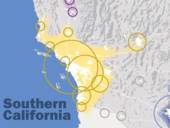 | |||||||||||
| Megapolitan areas of California | ||||||||||||
- Beverly Hills, California
- 1914 establishments in California
- Cities in Los Angeles County, California
- Incorporated cities and towns in California
- Populated places established in 1914
- Populated places in the Santa Monica Mountains
- Westside (Los Angeles County)
- Enclaves in the United States
- Armenian diaspora communities in the United States
- Iranian-Jewish culture in the United States
- Iranian-American culture in Los Angeles
- Iranian-American culture in California
